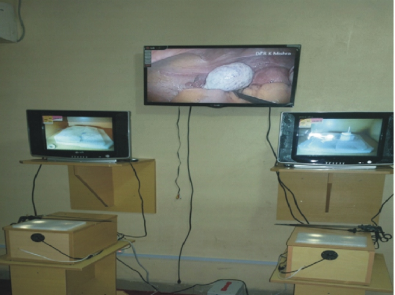An improvised endotrainer for low resource settings
Keywords:
Endotrainer, Minimal access surgery, low resource settingAbstract
Background: Training in minimal access surgery has always been difficult in developing countries with limited resources, paucity of animal laboratories, unaffordability / unaffordable conventional endotrainer and limited number of trained endoscopic surgeons to help the trainee.
Objective: To design an endotrainer for use in resource- poor settings with the aim of domestication of laparoscopic surgery.
Materials and Methods: A fabricated endotrainer box with a camera, a bulb for adequate illumination powered by electricity connected to a television was designed at affordable price to improvise for the conventional endotrainer for low resource settings. Results: The fabricated endotrainer model was found to be an effective training tool for improving psychomotor skills and dexterity of movement, especially for suturing in difficult areas. This is comparable to the sophisticated virtual reality simulator. Also, it is far less expensive compared to the expensive virtual reality simulator, thus affordable. Conclusion: It is concluded that this model should be employed by other low resource setting to improve the skills of surgeons in endoscopy surgery and facilitate the training of new hands.
References
Stephen W, Eubanks MD. Laparoscopy. In; Steve E, Lee L, Swanstrom MD, Nathaniel JS, editors. Mastery of Endoscopic and Laparoscopic Surgery. 2nd edition Lippincott Williams & Wilkins, 2004; p. 22-26.
Smith I. Anesthesia for laparoscopy with emphasis on outpatient laparoscopy.
Anesthesiol Clin North Am. 2001; 19:21-41.
Iqbal SM, Mohsin M, Anjum M, Shah A,
Tafazul M. A structured training module using an inexpensive endotrainer for improving the performance of trainee surgeons. Trop Doct. 2008; 38: 217-218.
Martin H, Kowon ST, Langbein S, Kamp S, Axel H, Peter A. Hans Christian Jacobaeus:
Inventor of Human Laparoscopy and Thoracoscopy. J Endo Urol. 2006; 20(11): 848-850.
Keyser EJ, Derossis AM, Antoniuk M, Sigman HH, Fried GM et al. A simplified simulator for training and evaluation of
laparoscopic skills. Surg Endosc
;14:149–53
Bhutani MS, Wong RF, Hoffman BJ. Training facilities in gastrointestinal endoscopy: an animal model as an aid to learning endoscopic ultrasound. Endoscopy 2006; 38 (9): 932934.
Heinkel VK, Kimmig JM. “Stomach models for training in gastrocamera examination and gastroscopy”. J Gastroenterol 2003; 57(1): 8-16.
Sorbi D, Vazquez-Sequeiros E, Wiersema MJ. A simple phantom for learning EUSguided FNA. Gastrol intest Endosc 2003; 57 (4): 580-83.
Ahlberg G, Enochsson L, Gallagher AG, Hedman L, Hogman C, McClusky DA 3 rd , et al . Proficiency-based virtual reality training significantly reduces the error rate for residents during their first 10 laparoscopic cholicystectomies. Am J Surg 2007;
:797-804.
Rassweiler J, Klein J, Teber D, Schulze M, Frede T. Mechanical simulators for training for laparoscopic surgery in urology. J Endourol 2007; 21:252-62.
Powers TW, Murayama KM, Toyama. House staff performance is improved by participation in a laparoscopic skills curriculum. Am J Surg 2002;184:626–9.
Munz Y, Kumar BD, Moorthy K, Bann S, Darzi A. Laparoscopic virtual reality and box trainers; Is one superior to other? Surg Endosc 2004;18:485–94.

Downloads
Published
How to Cite
Issue
Section
License
Copyright (c) 2023 Research Journal of Health Sciences

This work is licensed under a Creative Commons Attribution-NonCommercial-NoDerivatives 4.0 International License.
Research Journal of Health Sciences journal is a peer reviewed, Open Access journal. The Journal subscribed to terms and conditions of Open Access publication. Articles are distributed under the terms of Creative Commons License (CC BY-NC-ND 4.0). (http://creativecommons.org/licences/by-nc-nd/4.0). All articles are made freely accessible for everyone to read, download, copy and distribute as long as appropriate credit is given and the new creations are licensed under the identical terms.

